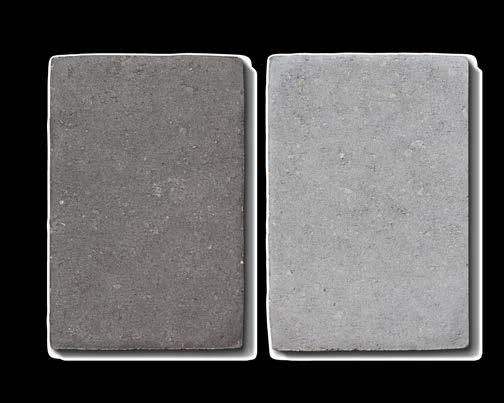INSTALLATION and care guide

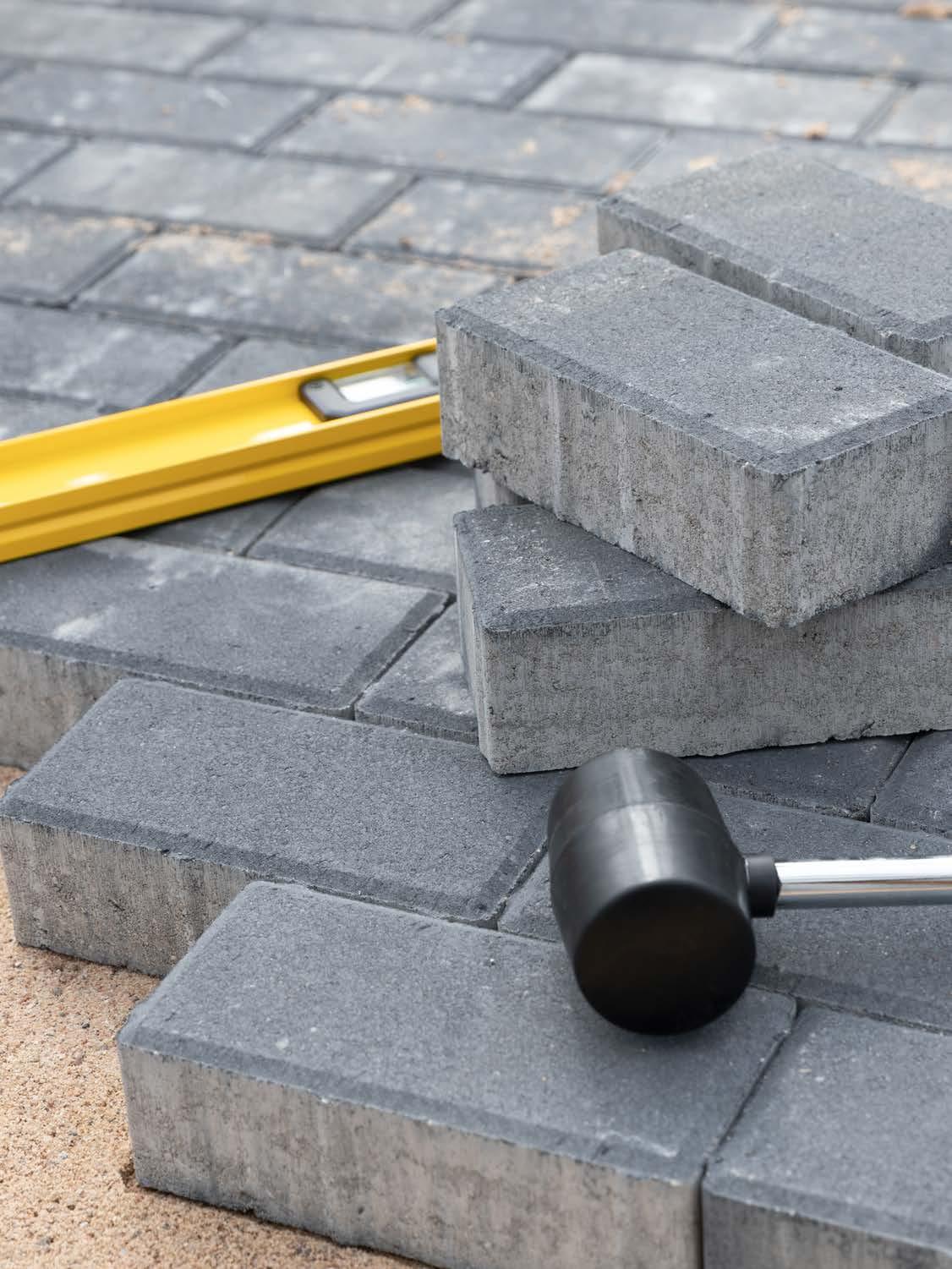
INSTALLATION GUIDE
Congratulations on purchasing the finest concrete pavers available. Ideal for any landscape setting, Interlock pavers have been designed to provide you with years of trouble free service and enjoyment.
Step-by-Step Installation
The directions in this guide are for the installation of a typical interlocking concrete driveway, patio or walkway. Before you begin, it is important to have your project fully designed on paper. If you require assistance with creating your design, or have any questions regarding installation, please consult your knowledgeable hardscape distributor or landscape professional.
Tools and Equipment Needed
• An 8' to 10' long straight 2 x 4 board for screeding
• Two 10' long, 1" dia. screeding guides (ie. water pipe, electrical conduit, wood strips, etc.)
• Standard carpenter’s level
• Trowel
• Gravel rake and shovels
• Wheelbarrow
• Broom
• Rubber mallet
• Tape measure
• Gloves, knee pads and safety glasses
• Wooden stakes or metal pegs
• Plate compactor (3 to 5 hp) and hand tamper
• Concrete saw with diamond blade (available at rental stores)
• Spray paint
• String
• String level
• Carpenter’s pencil
• Professional paver edge restraint
• Polymeric joint sand
Always call 811 Before You Dig
Calling 811 is the most important first step! Call 811 at least a few days before you start any digging project. Whether you are planning to do it yourself or hire a professional, smart digging means calling 811 before each job. Also, before planning your landscape project, check with your local zoning commission for building restrictions and required construction permits.
Beautiful and extremely durable, pavers offer a number of important advantages over conventional concrete or asphalt, including:
• High resistance to salt corrosion and the harmful effects of time and Mother Nature
• The ability to flex during frost heave without damage
• Easier installation/repair thanks to the use of individual pavers
• Easier removal when gaining access to underground services
• Rough surfaces make them more slip and skid resistant
• The side variety of styles, shapes and colors give them endless design possibilities
• Environmentally friendly; pavers can be reused indefinitely
Base Material and Joint Sand Calculators
Use this guide to help estimate how your minimum excavation depth and material requirements
Excavation Depth Guide:
Install Type Pedestrian Traffic Light Vehicular Traffic
Paver Height 2-3/8" (6cm) 2-3/8"
Bedding Sand Height 1" 1"
Gravel Base Depth (compacted) 4" – 6" 8" – 12"
Total Excavation Depth 7" – 9"* 11" – 15"*
Gravel Base Depth: Use minimum depths in a well-drained area or undisturbed soil. Use maximum depths in poorly drained area or disturbed soil. 1/2" less is required to compensate compacting of pavers. If soil is saturated more than 50% of the time, filter fabric and extra base should be used. *When installing 8cm or 10cm tall pavers, add 3/4" to 1-5/8" total excavation depth.
Base Material and Joint Sand Estimator
1) Granular base:
_________ Sq. ft. of pavers (x) (gravel base depth ÷ 12) ÷ 27
= ________ CUBIC YARDS OF BASE NEEDED
2) Bedding sand: (1" deep)
_________ Sq. ft. of pavers (x) 0.0031
= ________ CUBIC YARDS OF SAND NEEDED
3) Polymeric joint sand: (optional)
_________ Sq. ft. of pavers (÷) 60 (or 75 for narrow joints)
= ________ 50 LB. BAGS NEEDED
________ Sq. ft. of pavers (÷) 25 (or 40 for wide joints)
= _______ 50 LB. BAGS NEEDED
Open-graded paver base construction is prefered over sand-set construction for its lower cost and for use in wet-weather conditions. Both methods are acceptable for general pedestrian use applications
Design Notes:
1. Cross-section shown as suitable for sideways and patios.
2. Depth of aggregate base subject to site specific conditions such as soil conditions, groundwater levels, climate conditions, etc.
3. Depending on the permeability of subgrade soils, drain pipes should be placed within the aggregate base. Drainage needs should be verified with the geotechnical engineer. Drain pipes must be available to daylight via gravity flow to the surface or be connected to a catch basin.
4. Jointing sand that conforms to a ASTM C144 may be used in pedestrian applications.
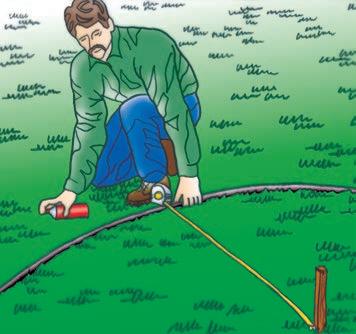
Create Outline
The first step is to take your completed design and transfer it onto the ground where you will be installing your patio. You can use spray paint to mark the outline, using a garden hose for guidance on the curved areas and long boards for the straight areas.
GETTING STARTED
Typical cross-section of open-graded paver base construction/installation.
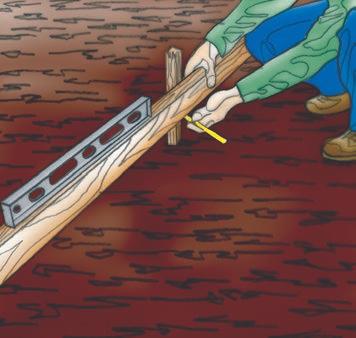
Set Elevations
Next, use a 2 x 4, stakes and a level to set the slope of your patio (a slope of approximately 1" to every 8 ft. is usually ideal). Now, set your stakes and string lines to mark the top of finished patio. Please refer to the Depth Estimation Chart.
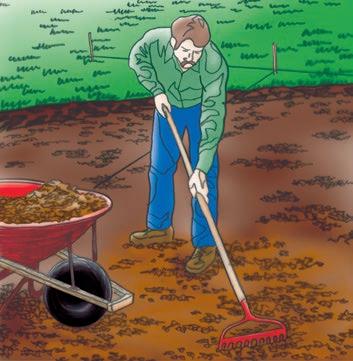
You are now ready to spread and compact the coarse granular base. Please refer to the Base Material Estimation to estimate the base material you will require. 2 3 1
Spread Granular Base
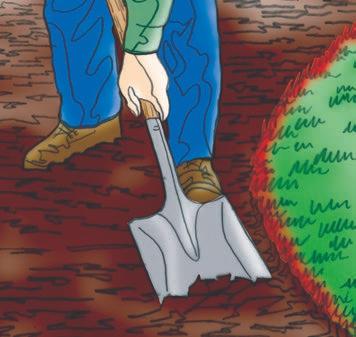
Excavate
Using your grid work of stakes and guide strings, excavate material below the string lines to the depth needed. To determine depth, refer to the Excavation Depth Guide. Note: Before any digging, call 811 for the location and depth of underground utilities..
INSTALLATION GUIDE
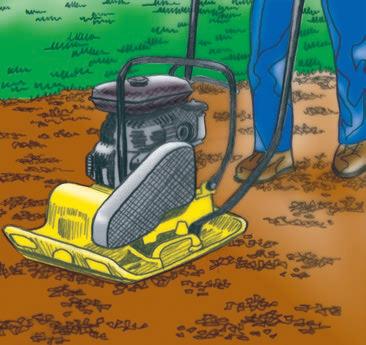
Compact Base
The granular base should be leveled and compacted (use a plate compactor) in layers of not more than 4". Wet, but do not soak the gravel base while compacting. Level the base to approximately 3" below the desired surface level. Make sure the base is level and conforms to the shape and elevation of the finished job by measuring down from the string lines you have established on the stakes.
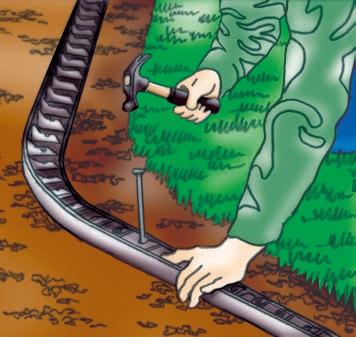
Install Edge Restraint
To prevent lateral movement of the pavers, edge restraints should be installed on compacted base along all edges which would otherwise be unrestrained. If possible, install edging only on one or two sides of the paving area. After pavers have been placed, install remainder of edging so as to avoid unnecessary cutting. 6
7 8
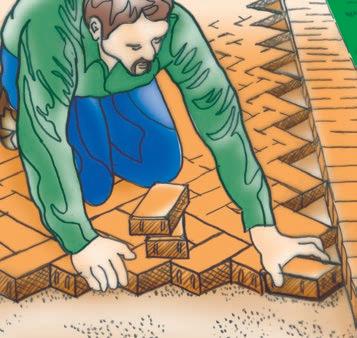
Lay Pavers
After screeding the sand begin laying your pavers, using the area’s straightest edge as your starting point. Pick a starting point where you can make the pavers fit against the longest straight edge or the longest combination of straight edges as long as they are at right angles to each other.
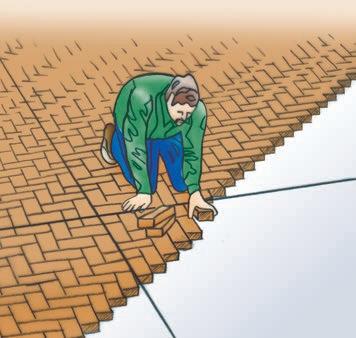
Keep Pavers Square
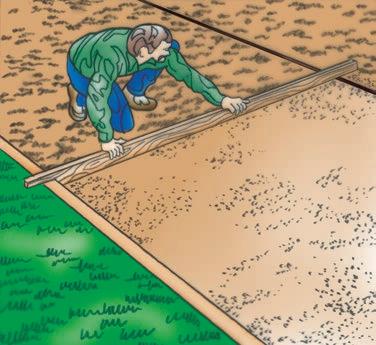
Spread Bedding Sand
Begin screeding (spreading) a 1" layer of large grained sand (such as concrete sand). Lay your screed guides (1" pipe, electrical conduit or wood strips) onto compacted base. Set the proper height of these guides by pulling a string across the area to be paved at the finished grade level. The top of screed guides should be 1-1/2" down from the string. Pack sand around the guides to set them in place. Fill with sand and slide the 8' to 10' screed board along the guides to smooth and level. Once complete, pull out the screed guides and fill any voids with sand using a trowel or small board. Do not walk on or work from the screeded sand.
9 10
To keep the pavers straight and square as you work, use a string line running in both directions as your guide. This is easily done by measuring out lines in multiples of 3, 4 and 5 with the line marked “three” remaining stationary during the squaring process. (See diagram below.) Line “four” should be moved until “four” and “five” intersect, causing a right angle in the “three-four” corner. If your pavers start to get off square, you can get them into proper position by gently tapping them towards the string line.
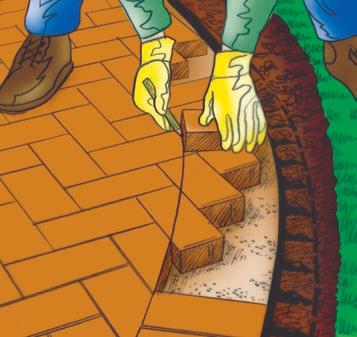
Cut to Fit
Many of the pavers that butt into the soldier course (strip of pavers all facing in the same direction) will need to be cut to fit properly. Using a concrete saw or guillotine splitter, cut each paver separately – marking it, removing it, cutting it and placing it – before proceeding to the next one. Always wear safety glasses when cutting pavers. Install the soldier course as you go along.
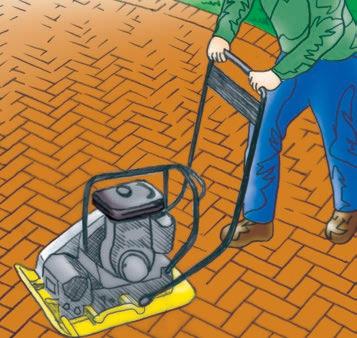
Compact
Sweep off the surface completely before using a roller compactor (or plate compactor with protective pad) to tamp the pavers to a uniform level. Run the compactor in a parallel direction across the pavers, overlapping on each pass. Make a second series of passes in a perpendicular direction. Important: for large profile pavers or a raised surface paver, set compactor to half speed and use a protective pad to prevent marking and scuffing pavers.
Note: To avoid surface damage to embossed pavers, N EVER use a metal plate compactor WITHOUT a protective pad. Doing so may void all warranties.
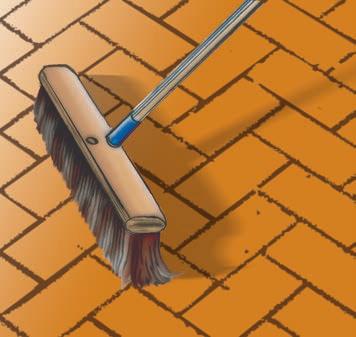
Remove Excess Polymeric Sand
Using a fine bristle broom or leaf blower, remove any excess polymeric sand from paver’s surface (without displacing the polymeric sand between the pavers).
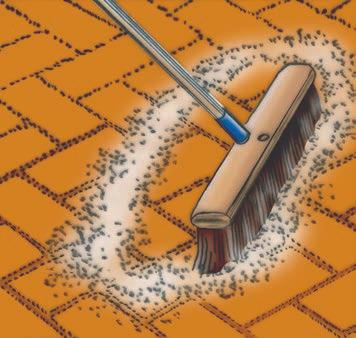
Spread Joint Sand
Regular sand option: Sweep coarse sand into all spaces between the finished pavers, repeating the process until all joints between the pavers are filled. Repeat this process with more dry sand in a few days.
Polymeric sand installation: Carefully read and understand manufacturers application instructions for installing polymeric sand. Sweep polymeric sand into all spaces between the finished pavers (surface must be completely dry).
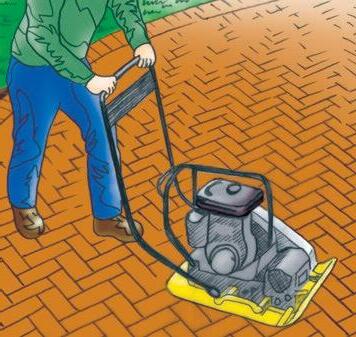
Compact
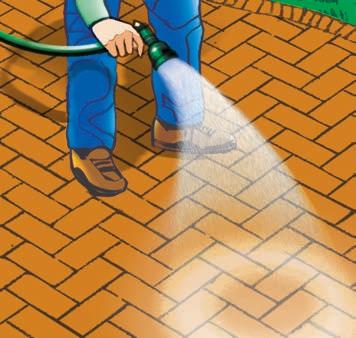
Activate Polymeric Sand
Follow manufacturers application instructions when activating polymeric sand. Define your working surfaces into 200 sq. ft. areas. Using the shower setting on garden hose sprayer, wet the first 200 sq. ft. area for 30 seconds (without displacing polymeric sand).
Sweep off the surface completely and use the plate compactor to tamp the pavers to a uniform level. Run the compactor in a parallel direction across the pavers, overlapping on each pass. Make a second series of passes in a perpendicular direction. Important: for large profile pavers or a raised surface paver, set compactor to half speed and use a uni-saver matt.
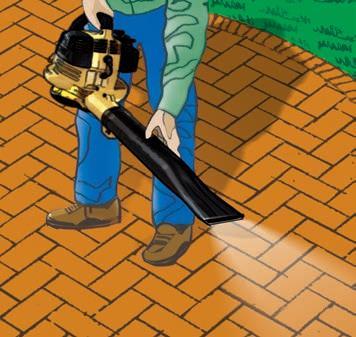
Drying
As soon as wetting process is completed, use a leaf blower to remove any excess water. The polymeric sand will set in 90 minutes. Avoid using or exposing the area to water for 24 hours.
Sealing
Read and follow manufacturers application instructions. Applying a protective sealer will help protect your pavers and keep them looking like the day they were installed. 14 13 15 16 11
PAVER CARE & MAINTENANCE
To keep your pavers in good condition and ensure their longevity, regular maintenance is essential. Here are some maintenance and care tasks you should consider for your new concrete pavers:
Regular Cleaning
Sweep the pavers regularly to remove loose dirt, leaves, and debris. You can also use a leaf blower or a pressure washer on a low setting to clean the surface. Avoid using excessive pressure, as it can damage the pavers and joint material.
Stain Removal
Promptly clean any stains or spills on the pavers to prevent them from setting in. For oil or grease stains, use an absorbent material like cat litter or sawdust to soak up the spill, then clean the area with a mild detergent and water. For other types of stains, you can use specialized concrete cleaners or a mixture of water and vinegar.
Weed Control
Regularly inspect the joints between the pavers for weed growth. Remove any weeds that emerge promptly to prevent them from taking root and causing damage. You can manually pull out the weeds or use herbicides specifically designed for paver joints, following the manufacturer's instructions.
Resealing
Concrete pavers can benefit from resealing every few years to protect them from stains, weathering, and fading. Check the manufacturer's recommendations for the appropriate sealer and resealing interval. Before resealing, ensure the pavers are thoroughly cleaned and dry.
Repairing Cracks
Unlike poured/stamped concrete, pavers are designed to resist damage from heaving due to freeze/thaw, tree roots, and subgrade changes. Broken pavers can be easily removed and replaced. If you notice any damaged pavers, repair them promptly to prevent further damage.
Preventing Debris Accumulation
To prevent debris from getting trapped between the paver joints and inhibiting drainage, use polymeric joint sand. This special sand hardens when exposed to moisture, creating a solid barrier that helps stabilize the pavers and reduce weed growth.
Avoiding Harsh Chemicals
Avoid using harsh chemicals or deicers that may damage the pavers or compromise the sealer. Ammonia-based cleaners, acid-based cleaners, and products containing bleach should be avoided.
Need Help, Ask a Professional
If you’re not quite the weekend warrior to tackle your own landscape construction or maintenance, talk to a professional. Landscape pros are invaluable assets for their design expertise, product knowledge, and construction and care methods.
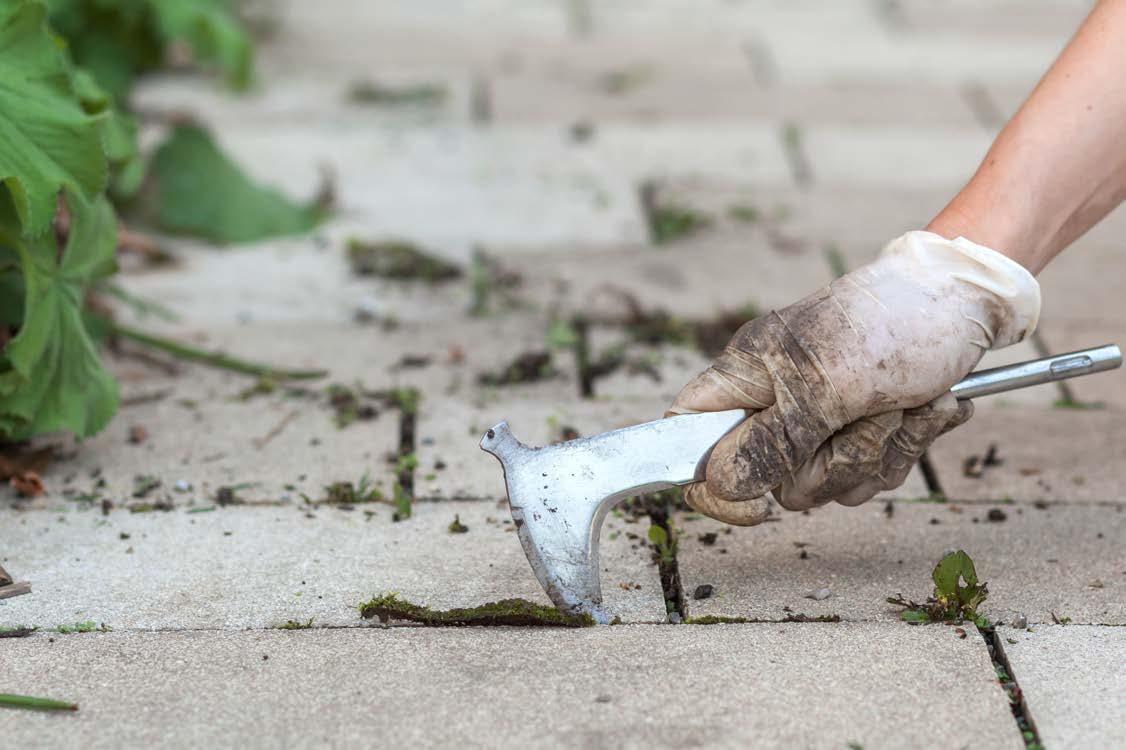

Like any decorative exterior surface, concrete pavers and landscape tiles aren’t immune to the effects of time, Mother Nature and heavy use.
Chroma Coloring System... a New Standard for vibrancy and consistency in paver color.
Smooth/closed surface with vibrant lasting facemix color layer
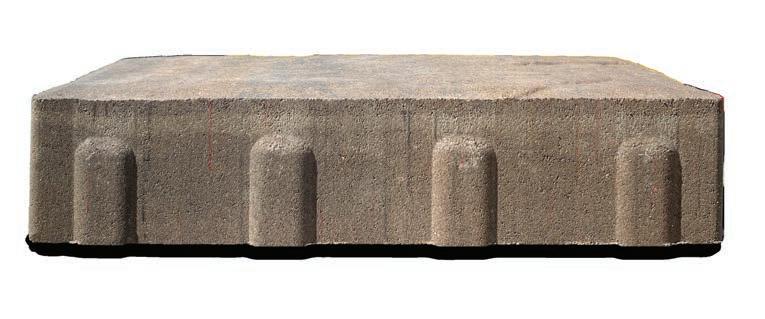
Smooth sides, strong auto spacers
Strong, high-cement-content base paver, made to last
This advanced manufacturing technology provides rich and vibrant colors across all of our most popular products. Chroma Coloring ensures consistent colors from batch to batch — pavers ordered in August will have the same consistent and vibrant color as pavers ordered in May.
Chroma Shield protected pavers stand up to the damaging effects of time and Mother Nature.
Chroma Shield manufactured pavers are highly resistant to fading and to the harmful effects of salt, chemical and acid rain exposure. Chroma Shield also provides some protection against stains and rust marks.
What is Chroma Shield?
The Chroma Shield manufacturing process is a series of chemical reactions between the paver and the Chroma Shield solution. As pavers are demolded, a proprietary aqueous-based solution is sprayed on the surface causing a chemical/molecular reaction that creates the Chroma Shield protective layer. This new protective compound penetrates into the surface of the paver three to five millimeters deep and can only be removed with heavy abrasion/wear.
Chroma Shield pavers are:
• Fade Resistant
• Stain Resistant
• Acid Rain Resistant
• Salt Resistant
• Spalling Resistant
• Inhibits Efflo and Poly Haze
Consistent/crisp edge and corner detail Without With Chroma Shield YEARS LATER, CHROMA SHIELD PAVERS REMAIN EXTREMELY FADE RESISTANT.
